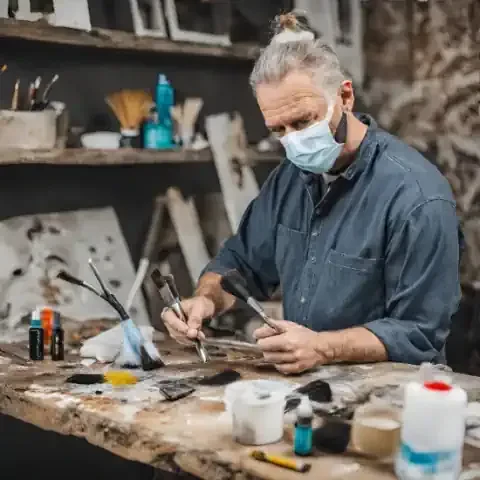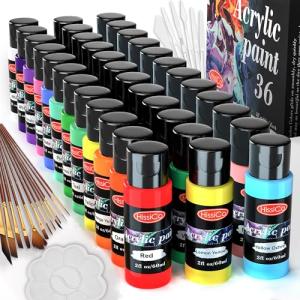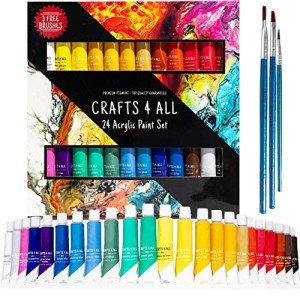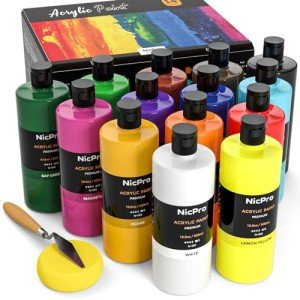The Significance of Properly Cleaning and Maintaining Art Supplies
Artists pour their heart and soul into their creations, but behind every masterpiece lies a meticulous process involving not just talent and inspiration, but also the care and maintenance of their tools. Whether you're an amateur enthusiast or a seasoned professional, understanding the importance of cleaning and maintaining your art supplies is paramount to ensuring the longevity of your materials and the quality of your work.
Preservation of Quality
Imagine painting with brushes caked in dried paint or using pencils with dull, broken tips. Neglected art supplies not only hinder the artistic process but also compromise the quality of your artwork. Proper maintenance ensures that your brushes retain their shape and softness, your paints remain vibrant and workable, and your surfaces stay pristine, allowing you to produce art with the finesse and precision it deserves.
Cost-Efficiency
Art supplies can be a significant investment, especially for artists who rely on high-quality materials to bring their visions to life. By taking proactive measures to clean and maintain your tools, you extend their lifespan, ultimately saving you money in the long run. Regular maintenance minimizes the need for frequent replacements and prevents the wastage of materials due to neglect or improper storage.
Health and Safety
Many art materials contain chemicals and substances that can be harmful if mishandled or left unattended. Proper cleaning not only ensures the longevity of your supplies but also mitigates health risks associated with prolonged exposure to hazardous substances. Additionally, maintaining a clean and organized workspace promotes better air quality and reduces the likelihood of accidents or injuries during the creative process.
Consistency in Performance
Consistency is key to artistic success. Whether you're working on a series of paintings or experimenting with different mediums, having well-maintained art supplies ensures consistent performance across projects. Clean brushes provide smoother strokes, properly stored paints offer optimal color consistency, and well-kept surfaces provide the ideal canvas for your artistic expression, allowing you to focus on refining your skills and techniques without unnecessary distractions.
Respect for Your Craft
Caring for your art supplies is a testament to your dedication and respect for the craft. It reflects a commitment to excellence and a willingness to go the extra mile to preserve the integrity of your materials. Just as a chef maintains their knives or a musician tunes their instrument, an artist honors their tools by keeping them in pristine condition, acknowledging the indispensable role they play in the creative process.
In the subsequent sections of this article, we will delve into the specific techniques and practices for cleaning and maintaining various art supplies, equipping you with the knowledge and skills necessary to safeguard your tools and unleash your artistic potential. Whether you're a novice artist eager to learn the basics or a seasoned creator looking to refine your approach, mastering the art of maintenance is a crucial step towards achieving artistic excellence.
Cleaning Brushes
Brushes are the artist's primary tools, serving as extensions of their creativity and expression. Whether you're working with acrylics, oils, watercolors, or any other medium, the proper care of your brushes is essential for achieving desired results and preserving their longevity.
Materials Needed
Before diving into the cleaning process, gather the following materials
Mild soap or brush cleaner
Lukewarm water
Paper towels or lint-free cloths
Brush conditioner or hair conditioner (for natural hair brushes)
Brush holder or drying rack
Step-by-Step Guide
Removing Paint Residue
After completing your artwork, gently wipe off excess paint from the bristles using a paper towel or cloth. Avoid pressing too hard, as this can damage the brush fibers.
For stubborn residue, consider using a brush cleaner specifically formulated for the type of paint you're using. Apply a small amount to the bristles and gently work it in with your fingers, then rinse thoroughly.
Washing with Soap and Water
Fill a container with lukewarm water and add a small amount of mild soap or brush cleaner.
Swirl the brush in the soapy water, working up a lather to remove any remaining paint and debris.
Rinse the brush thoroughly under running water, gently reshaping the bristles with your fingers to ensure all soap residue is removed.
Conditioning and Shaping
For natural hair brushes, apply a small amount of brush conditioner or hair conditioner to the bristles. Work it in gently with your fingers, then rinse thoroughly.
Reshape the brush to its original form by gently molding the bristles with your fingers. Avoid excessive force, as this can cause damage.
Hang the brushes upside down or lay them flat to dry on a clean surface, ensuring proper airflow to prevent mildew or mold growth.
Tips for Different Types of Brushes
Synthetic Brushes: Synthetic brushes are generally more durable and easier to clean than natural hair brushes. Follow the same cleaning process outlined above, paying attention to any specific care instructions provided by the manufacturer.
Natural Hair Brushes: Brushes made from natural hair require extra care to maintain their softness and shape. Use a gentle brush conditioner to keep the bristles supple and avoid harsh chemicals that can cause damage.
By incorporating regular brush cleaning into your artistic routine, you not only prolong the lifespan of your brushes but also ensure consistent performance and optimal results in your artwork. Stay tuned for the next part of this article, where we'll explore techniques for caring for paints and pigments, another essential aspect of art supply maintenance.
Caring for Paints and Pigments
Just as brushes are essential tools for artists, paints and pigments are the vibrant mediums through which their visions come to life. Whether you work with acrylics, oils, watercolors, or any other type of paint, proper care and maintenance are crucial for preserving their quality and ensuring optimal performance.
Proper Storage Techniques
Sealing Containers: Keep paint tubes tightly sealed when not in use to prevent air from drying them out. For watercolor pans or palettes, cover them with a lid or plastic wrap to maintain moisture levels.
Temperature Control: Store paints in a cool, dry place away from direct sunlight and extreme temperatures. High heat can cause paints to dry out or separate, while cold temperatures may affect their consistency.
Organized Workspace: Maintain a clean and organized workspace to prevent accidental spills or contamination of paint supplies. Use shelves, drawers, or storage boxes to keep paints neatly organized and easily accessible.
Preventing Drying and Clumping
Moisture Control: Add a damp sponge or paper towel to the palette or paint box to maintain humidity levels and prevent acrylics and watercolors from drying out too quickly.
Regular Stirring: Stir oil paints regularly to prevent separation and ensure uniform consistency. Use a palette knife or paintbrush to mix the pigments thoroughly before each use.
Avoiding Contamination: Use clean brushes and palette knives when working with paints to prevent cross-contamination and preserve the purity of color mixtures. Clean palettes and mixing surfaces between painting sessions to prevent dried paint from interfering with new color applications.
Reviving Dried Paints
Adding Mediums: For acrylic paints, add a small amount of acrylic medium or water to dried-out paint to revive its consistency. Mix the medium thoroughly with the paint until smooth and creamy.
Solvent Use: When working with oil paints, use a solvent such as linseed oil or turpentine to loosen dried paint and restore its fluidity. Apply the solvent sparingly and mix it thoroughly with the paint until the desired consistency is achieved.
Rehydrating Watercolors: Spritz dried watercolor pans or palettes with water and allow them to sit for a few minutes to rehydrate the pigments. Use a damp brush to pick up the softened paint and continue painting as usual.
By implementing these techniques for caring for your paints and pigments, you can ensure that your colors remain vibrant, your mixtures stay consistent, and your artworks maintain their integrity over time. In the next part of this article, we'll explore specific guidelines for handling different types of paints, including acrylics, oils, and watercolors, to help you achieve optimal results in your artistic endeavors.
Maintaining Drawing Materials
While brushes and paints are essential for many artists, drawing materials like pencils, charcoal, and pastels are equally vital tools for creating stunning artworks. Proper care and maintenance of these materials not only ensure their longevity but also contribute to the precision and quality of your drawings.
Pencil Care
Sharpening Tips: Use a high-quality pencil sharpener to sharpen pencils to a fine point. Avoid over-sharpening, as this can lead to breakage or waste of the pencil core. Additionally, consider using a sandpaper block to gently sharpen pencils for precise, controlled lines.
Preventing Breakage: Handle pencils with care to prevent breakage of the lead core. Avoid dropping or applying excessive pressure when drawing, and always store pencils in a protective case or container to prevent damage.
Charcoal and Pastels
Dust Management: Charcoal and pastels can produce a significant amount of dust, which can smudge your drawings and create a mess in your workspace. Use a fixative spray to seal charcoal and pastel drawings and prevent smudging. Alternatively, work in a well-ventilated area and use a soft brush to gently remove excess dust from your artwork.
Fixative Use: When applying fixative spray to charcoal and pastel drawings, hold the can at arm's length and spray lightly and evenly over the surface of the artwork. Allow the fixative to dry completely before handling the drawing to avoid smudging or streaking.
Erasers and Correctors
Cleaning Techniques: Erasers and correctors can accumulate dirt and pigment residue over time, affecting their performance. Periodically clean erasers by gently rubbing them against a clean surface or using a kneaded eraser to pick up debris. For correction fluids or tapes, wipe the applicator tip clean after each use to prevent clogging and ensure smooth application.
Paper Care
Protecting from Moisture and Sunlight: Store drawing paper in a dry, cool environment away from direct sunlight and moisture, which can cause the paper to warp or degrade over time. Consider using acid-free or archival-quality paper to ensure the longevity of your drawings and prevent yellowing or fading.
By incorporating these practices into your artistic routine, you can prolong the lifespan of your drawing materials and maintain the quality of your artwork. In the next part of this article, we'll explore techniques for preserving canvases and surfaces, providing you with comprehensive guidelines for caring for all your art supplies.
Preserving Canvases and Surfaces
Canvases and surfaces serve as the foundation for your artwork, providing the support and texture necessary for your creative endeavors. Whether you work on stretched canvas, paper, or wood panels, proper care and maintenance of these surfaces are essential for ensuring the longevity and integrity of your finished artworks.
Cleaning Canvas
Dust Removal: Before starting a new artwork or storing a finished piece, gently brush off any dust or debris from the surface of the canvas using a soft brush or lint-free cloth. Avoid using abrasive materials or excessive force, as this can damage the canvas fibers or remove paint layers.
Surface Cleaning: For more stubborn stains or dirt buildup, lightly dampen a clean cloth with water and gently wipe the surface of the canvas in a circular motion. Use caution to avoid saturating the canvas with water, as this can cause warping or damage to the paint layers.
Storing Finished Artworks
Flat Storage: When storing finished artworks, lay them flat in a clean, dry area away from direct sunlight and moisture. Place a protective sheet of acid-free paper or glassine between stacked artworks to prevent sticking or smudging.
Proper Framing: Consider framing finished artworks to provide additional protection from dust, moisture, and handling. Choose archival-quality frames and mats to ensure the longevity of your artwork and prevent deterioration over time.
Preventing Yellowing and Damage
UV Protection: To prevent yellowing and fading of canvas and paper artworks, avoid displaying them in direct sunlight or harsh artificial light. Consider using UV-filtering glass or acrylic glazing when framing artworks to provide added protection against harmful ultraviolet rays.
Humidity Control: Maintain stable humidity levels in your workspace to prevent warping or buckling of canvas and paper surfaces. Use a dehumidifier or humidifier as needed to regulate moisture levels, especially in environments prone to fluctuations in humidity.
By implementing these practices for preserving canvases and surfaces, you can ensure the longevity and integrity of your artworks, allowing you to showcase your creations with confidence and pride. In the next part of this article, we'll explore maintenance techniques for other art supplies, including erasers, paper, and additional tools, providing you with comprehensive guidelines for caring for all aspects of your artistic materials.
Maintenance of Other Supplies
Beyond brushes, paints, and surfaces, artists rely on a variety of other supplies and tools to bring their creative visions to life. From erasers to paper, each component plays a crucial role in the artistic process. Here, we delve into the maintenance techniques for these additional supplies to ensure they remain in optimal condition for your artistic endeavors.
Erasers and Correctors
Cleaning Techniques: Erasers, whether plastic, gum, or kneaded, can accumulate dirt, graphite, or pigment residue over time, affecting their effectiveness. Periodically clean erasers by gently rubbing them against a clean surface or using a kneaded eraser to pick up debris. Avoid pressing too hard, as this can damage the eraser's texture and performance.
Paper Care
Storage Considerations: Store paper in a cool, dry environment away from direct sunlight and moisture to prevent yellowing or degradation. Use acid-free or archival-quality paper to ensure the longevity of your artworks and prevent discoloration over time.
Handling Precautions: When working with paper, handle it with care to avoid creases, tears, or smudges. Use clean hands or wear cotton gloves to prevent transferring oils or dirt onto the paper surface.
Additional Tools
Brush Holder or Drying Rack: Invest in a brush holder or drying rack to properly store and dry brushes after cleaning. Hanging brushes upside down or laying them flat ensures proper airflow and prevents bristles from becoming misshapen or damaged.
Palette Knife Maintenance: Clean palette knives thoroughly after each use to prevent dried paint buildup and maintain their effectiveness. Use a solvent such as mineral spirits or turpentine to remove stubborn paint residue, and wipe the knife clean with a lint-free cloth.
Cutting Tools: Keep cutting tools such as scissors, craft knives, or rotary cutters sharp and clean for precise cuts and smooth edges. Regularly sharpen blades using appropriate sharpening tools and wipe them clean after each use to prevent rust or corrosion.
By incorporating these maintenance techniques into your artistic routine, you can ensure that all your supplies and tools remain in optimal condition, allowing you to focus on your creative process without the distraction of malfunctioning or damaged materials. Stay tuned for the conclusion of this article, where we'll recap the importance of regular maintenance and provide final tips for artists to enhance their creative practice.
Safety Precautions
While creativity and expression are at the forefront of the artistic process, it's equally important to prioritize safety when working with art supplies. Many art materials contain chemicals and substances that can pose health risks if mishandled or improperly used. In this section, we'll discuss essential safety precautions to ensure your well-being while creating art.
Proper Ventilation
Workspace Ventilation: Work in a well-ventilated area to minimize exposure to fumes and airborne particles from paints, solvents, and adhesives. Open windows or use fans to improve airflow and reduce the concentration of harmful substances in the air.
Use of Respiratory Protection: When working with aerosol sprays, oil-based paints, or other materials that produce strong fumes, consider wearing a respirator or mask to protect your respiratory system from inhalation hazards. Choose a mask specifically designed for art-related activities and follow manufacturer instructions for proper use.
Handling Hazardous Materials
Read Labels and Safety Data Sheets: Familiarize yourself with the safety precautions and handling instructions provided on product labels and safety data sheets for art supplies. Pay attention to warnings regarding toxicity, flammability, and other potential hazards, and follow recommended safety guidelines accordingly.
Gloves and Protective Clothing: When working with materials that may irritate or stain the skin, such as certain paints, adhesives, or solvents, wear protective gloves and clothing to minimize direct contact. Choose gloves made from materials resistant to chemical exposure, such as nitrile or latex.
Storage and Disposal
Secure Storage: Store hazardous materials, such as solvents, varnishes, and adhesives, in a secure location away from children and pets. Use designated containers or cabinets to prevent spills, leaks, or accidental exposure.
Proper Disposal: Dispose of hazardous materials and waste according to local regulations and guidelines. Avoid pouring chemicals down drains or disposing of them in regular household trash. Instead, follow municipal guidelines for hazardous waste disposal or recycling.
By prioritizing safety and taking proactive measures to minimize risks when working with art supplies, you can create a safer and healthier environment for yourself and those around you. Remember that your well-being is paramount, and incorporating safety precautions into your artistic practice is an essential part of being a responsible and conscientious artist.
Conclusion
In the realm of artistry, the journey from imagination to creation is paved with dedication, passion, and attention to detail. Throughout this article, we've explored the vital importance of cleaning and maintaining your art supplies to ensure their longevity and optimal performance. From brushes and paints to canvases and drawing materials, each component plays a crucial role in the artistic process, deserving of care and respect.
By incorporating regular maintenance into your artistic routine, you not only preserve the integrity of your materials but also elevate the quality of your artwork. Properly cleaned and maintained brushes offer smoother strokes, well-cared-for paints provide vibrant colors, and meticulously preserved surfaces offer the perfect canvas for your creativity to flourish.
Moreover, prioritizing safety in your artistic practice ensures not only the protection of your physical well-being but also the sustainability of your artistic endeavors in the long term. By following safety precautions and handling hazardous materials responsibly, you create a safer and healthier environment for yourself and those around you.
As you embark on your artistic journey, remember that the care and maintenance of your art supplies are not just tasks to be checked off a list but rather acts of reverence for the tools that empower your creativity. Embrace the opportunity to nurture your materials, and in doing so, you honor the craft and commitment that define the essence of artistry.
May your brushes be ever soft, your paints ever vibrant, and your creations ever inspired. Here's to a future filled with boundless creativity and artistry, supported by the steadfast care and maintenance of your cherished supplies.







